Dealing with fungus gnats in household plants can be a common nuisance, but I’m going to share some simple steps you can take to naturally eliminate fungus gnats—FOR GOOD! From adjusting watering habits to using natural remedies, getting rid of these pesky insects simply takes a bit of diligence and time.
The key to getting rid of fungus gnats is to eliminate the larvae. But it can be tricky to do this naturally. Since the adults only live for a few days, once all the larvae is dead, the infestation will go away pretty quickly.
This is easier said than done though. The adults can fly, jump, or crawl from one plant to the next, so it can be difficult to eradicate them.
So you have to be persistent in treating them, and ensure that you are diligent about keeping your houseplants healthy to prevent recurring outbreaks.
A Bit About Fungus Gnats
Fungus gnats are tiny black bugs that crawl on top of the soil and fly around your houseplants. They are the most common houseplant pest there is, and they can quickly infest your entire collection. Yuck!
Though the look very similar to fruit flies, they are not the same type of bug. You can read all about how to tell the difference between the two here, so you can make a positive ID.
Fungus Can Multiply Quickly!
There are 4 stages to the fungus gnat life cycle. In the right environment, they can multiply very quickly, and their full lifespan can happen in less than a month.
The adults only live for a week or so, but the females can lay hundreds of eggs during their life. So if you don’t take the right steps to eliminate them, their population can explode in a short amount of time.

9 Natural Fungus Gnat Treatments
There’s no need to resort to chemical pesticides, you can easily fight these pests using natural and organic treatment methods. For the quickest results, you should try all of these:
1. Proper Watering
The #1 reason fungus gnats get into your plants is from overwatering. The larvae thrive in wet soil, and they can’t survive when it’s dry.
So, the easiest and most effective method of eliminating them is to make sure you always water your houseplants correctly. The soil should feel dry to the touch, and never be saturated or soggy.
If you struggle with this, I highly recommend getting an inexpensive moisture gauge to make sure you get it right every time.
2. Water From The Bottom
Fungus gnat larvae live in the top 1 inch of the soil, which tends to stay pretty moist when you water plants from the top. So if you have persistent problems, then try watering from the bottom instead.
To do that, simply pour water into the drip tray or cache pot, and allow the plant to soak it up through the drainage holes in the bottom of the container.
Always dump out any remaining water after about 20-30 minutes, and never leave your plant soaking for longer than that.
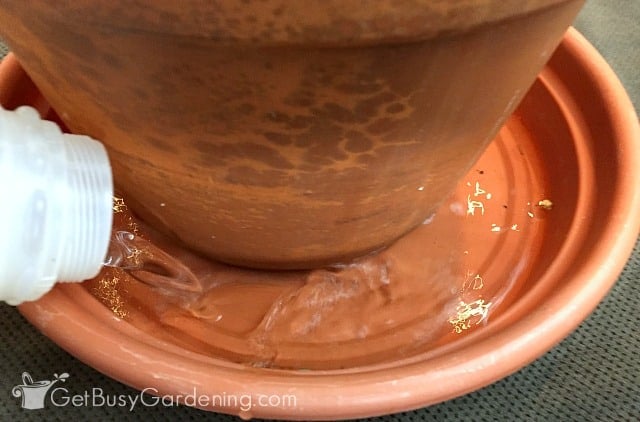
3. Use Gnat Traps
Putting a yellow sticky trap near your indoor plants is a super safe pest control method that will attract and capture the flying adults.
This only works to control the adult population, it will not take care of the problem at the source – the larvae.
But these traps will definitely prevent fungus gnats from flying around to other plants and prevent more larvae from being laid.
Try making your own DIY Fruit Fly Trap!
4. Use Organic Products
There are several organic products that you can pour over the top of the soil to help kill the gnat eggs, larvae, and pupa.
It might take a few applications to see results, and you also have to be careful not to overwater your plants in the process but they are natural. Here are a few of my favorites:
- Insecticidal soap – This will kill any bugs in the soil on contact. You could also make your own by mixing 1 teaspoon mild liquid soap with 1 liter of water.
- Neem oil – This is a natural pesticide that works to kill houseplant pests over time, and it has a residual effect to help keep them away.
- Beneficial nematodes – These are microscopic organisms that will feed on the pupa and larvae, and you can simply add them to your watering can.
- Bacillus thuringiensis israelensis (BTI) – Also known as mosquito dunks or mosquito bits, BTI is a bacteria that’s only toxic to the larvae of bugs like fungus gnats. It takes some time for it to be effective but works.
Related Post: How To Use Neem Oil As Organic Pest Control
5. Remove Gnat Infested Soil Entirely
Remove the top inch of soil and replace it with fresh, sterile, and dry potting mix. This will get rid of most of the fungus gnat eggs, larvae, and pupa, and make it easier for you to gain the upper hand.
Just keep in mind that the eggs could still hatch and mature after you remove it from your houseplant, so make sure you take the infested soil outside to the trash right away.
6. Use Soil Covers
Rather than refreshing the top inch of soil, you can add a dry layer of fine sand, gravel, or crushed granite instead. This will help deter the females from laying eggs. Plus it creates a nice decorative touch.
Or you could try a barrier top dressing, which is a non-toxic product that is specifically made for eradicating fungus gnats.
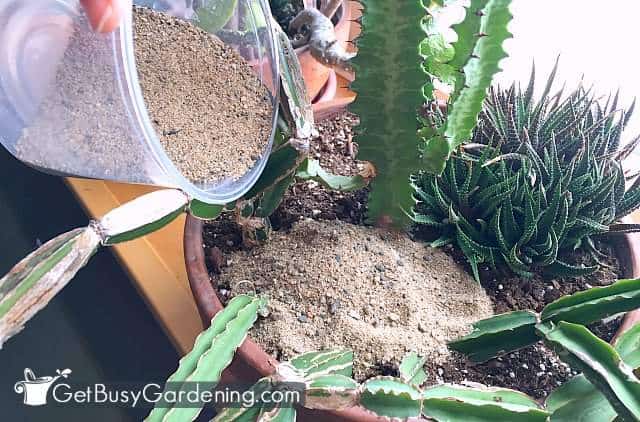
7. Store Unused Soil In A Sealed Container
Bags of potting soil can become a breeding ground for fungus gnats. So it’s important to store any of your unused mediums in sealed containers, especially if you keep them inside the house.
Fungus gnats can’t survive without oxygen, so make sure the container is airtight. I store mine in five gallon buckets with Gamma seal lids on top.
8. Never Reuse Potting Soil
I know it’s tempting to pinch pennies by reusing soil when you repot your indoor plants or after one dies, but you’re just asking for trouble.
Used soil can harbor all sorts of pests and diseases, and can quickly cause an infestation. So it’s always best to use a fresh, sterile mix, and discard the old stuff.
Related Post: 9 Homemade Insecticides & Bug Sprays For Indoor Plants
9. Use Hydrogen Peroxide as Larvacide
Treating the soil with hydrogen peroxide is a natural and effective method. Try mixing 1 part hydrogen peroxide to 4 parts water and use it to wet the top inch. Keep in mind that this will only kill the larvae and pupa, and not the adults that are flying around your plant.
Other Natural Treatments To Try
I have also heard using baking powder, vinegar, coffee grinds, tea tree oil, lavender oil, garlic, parsley, cinnamon can be effective treatments for ridding of fungus gnats.
Where Do Fungus Gnats Come From?
Though indoor plant bugs can come from anywhere, here are the 4 most common ways that fungus gnats could have gotten into your house:
- From the soil of a new pre-infested plant.
- An infested bag of potting mix.
- Other plants that were outside during the summer.
- Through the screen of open windows or doors.
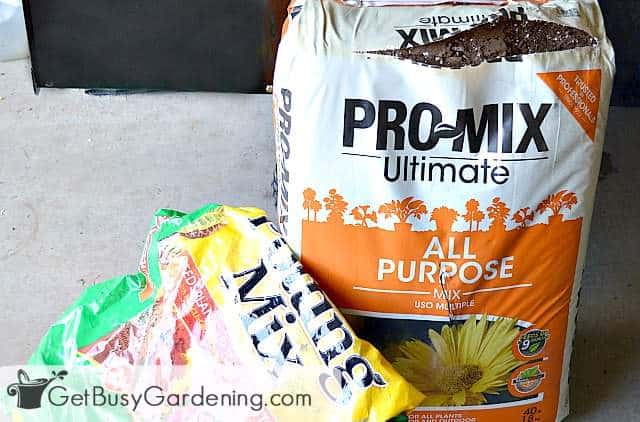
Related Post: How To Get Rid Of Houseplant Bugs Naturally
Common Questions About Fungus Gnats
While it is possible to get rid of fungus gnats, you have to be diligent with your preventative measures to keep them away permanently. The biggest problem is that they can easily come through window screens and doors. So unless you seal your home year round, it’s possible the fungus gnats will return at some point.
The short answer is no, fungus gnats will not kill your houseplants. They are usually just a nuisance and rarely destructive. Sometimes they can cause minor root damage if the infestation is heavy, but normally they only eat rotting plant material.
Everyone with indoor plants will have to fight fungus gnats at some point, it’s just a part of life. Recurring problems are difficult to prevent, and it can be very frustrating. Your best defense is to make sure you don’t overwater, properly store unused potting soil, and always maintain healthy houseplants.
If houseplant pests are driving you crazy, and you want to learn how to get rid of them once and for all, check out my Houseplant Pest Control eBook. It will help you identify common houseplant bugs, and show you exactly how to eradicate them before they kill your beloved plants. Download your copy today!
More About Houseplant Pests
- How To Debug Plants Before Bringing Them Indoors
- How To Get Rid Of Thrips On Indoor Plants
- How To Get Rid Of Spider Mites On Indoor Plants
- How To Get Rid Of Scale Insects On Houseplants
- How To Get Rid Of Whiteflies On Indoor Plants
- How To Get Rid Of Aphids On Houseplants
- How To Get Rid Of Mealybugs On Your Houseplants
Leave a comment below and share your tips for how to get rid of fungus gnats in houseplant soil.


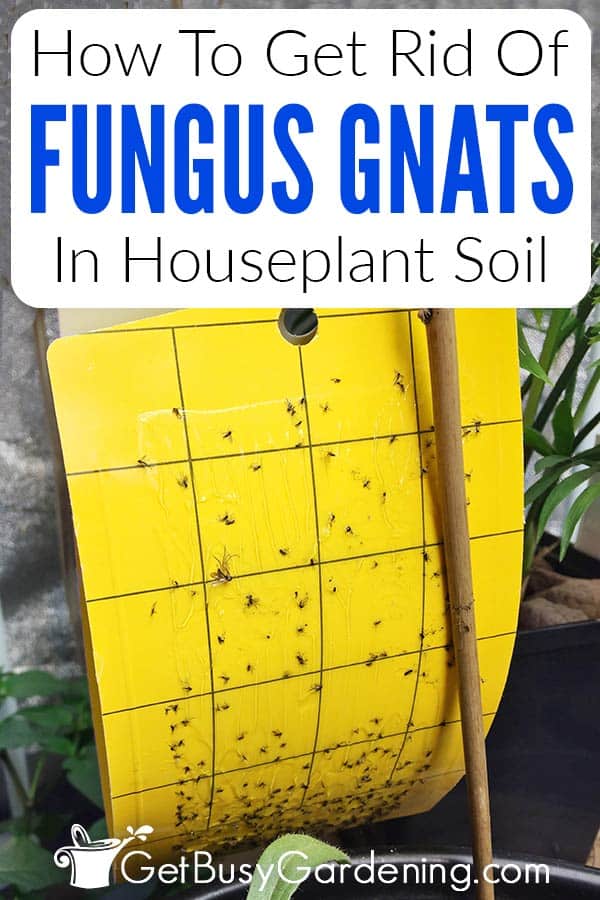

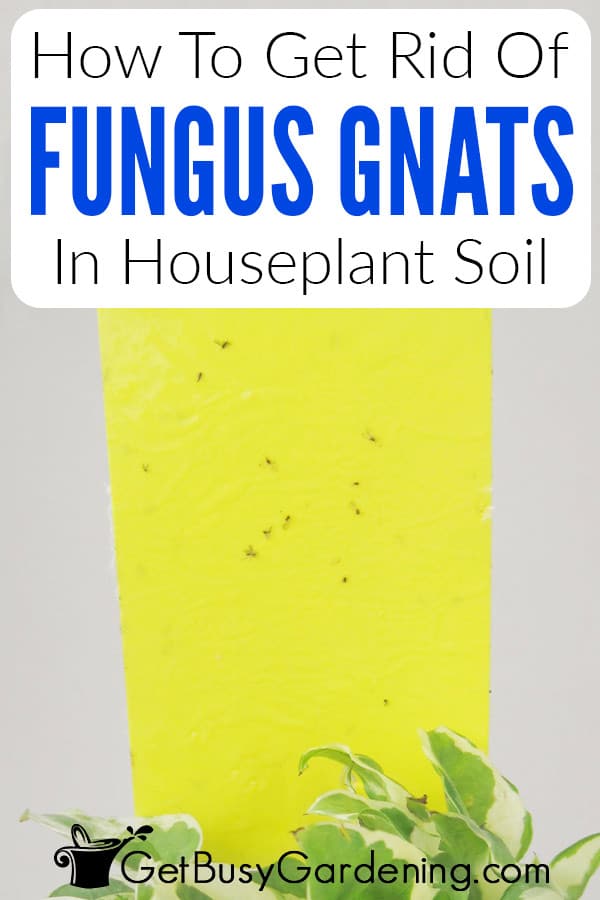
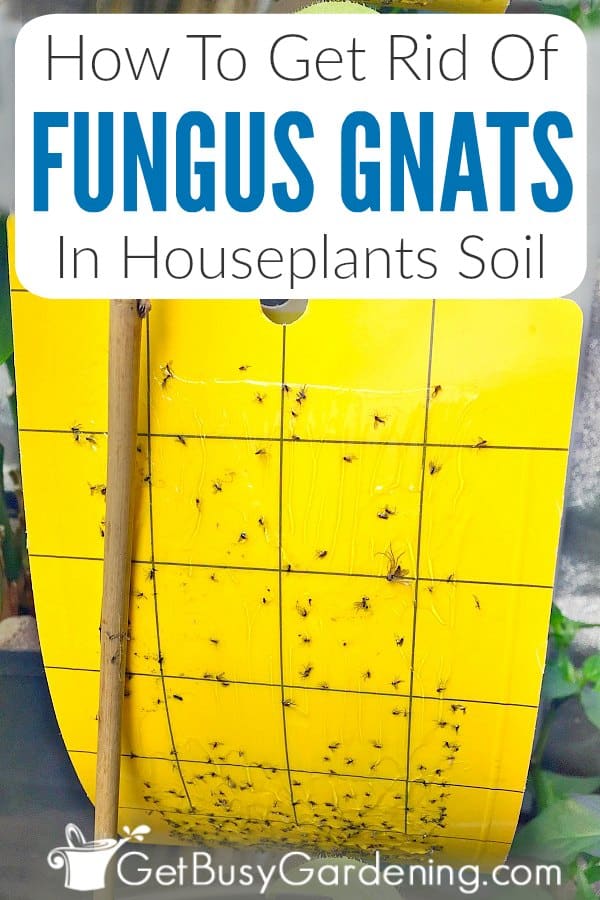
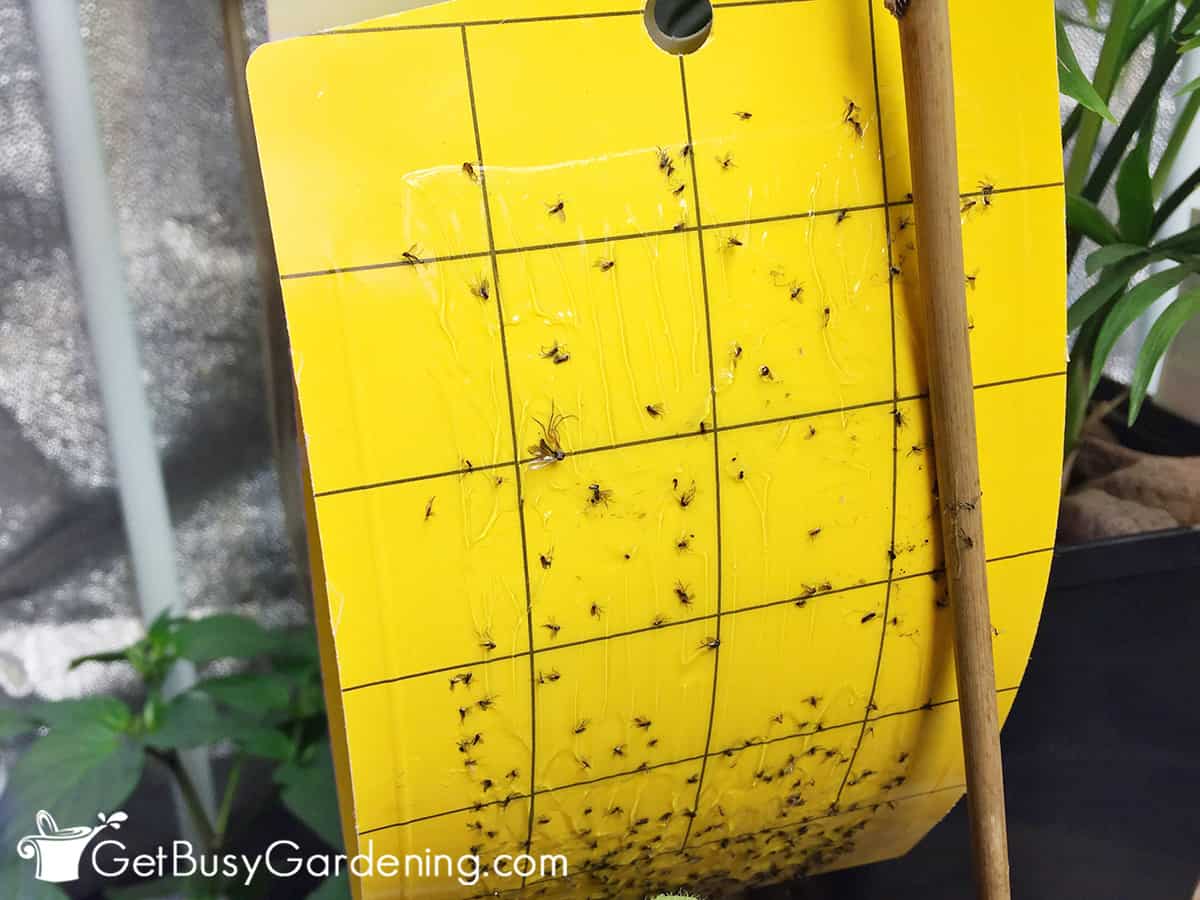


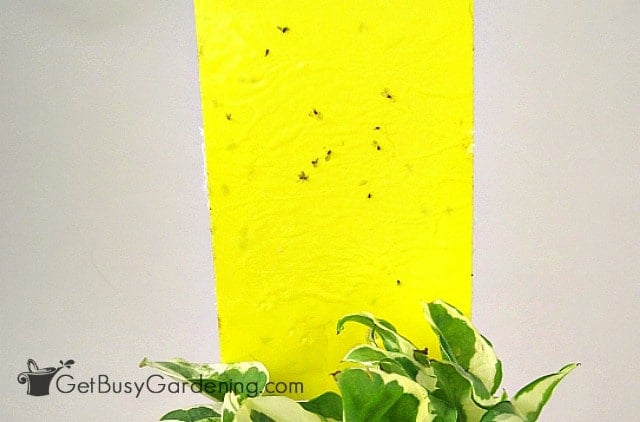
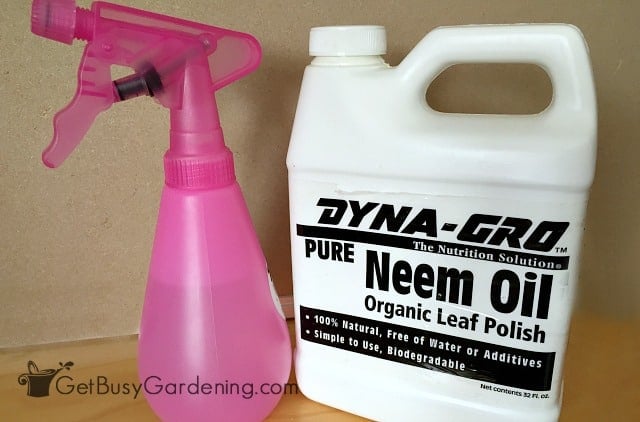
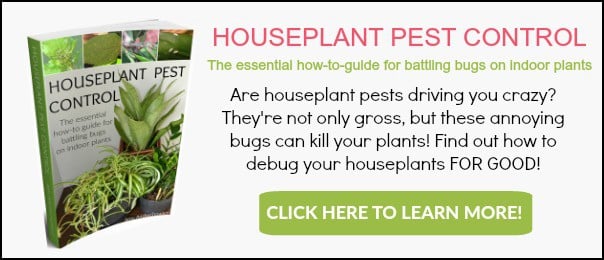

Ellen says
Hi Amy, Thanks so much for your help. I live in a country where Neem oil is not available and pesticides are too strong for household plants. If I use the antibacterial soap, can you advise the proportions of soap to water per medium potted plant? Do I just water the plant with this mixture? It won’t kill the plant, will it?
Amy Andrychowicz says
I use 1 teaspoon of liquid soap per liter of water. Make sure you use a mild liquid soap.
Allyson says
Hi, just wondering can I use the decorative flat glass marbles that you sometimes see in glass vases or aquariums for a plant cover against gnats? Thanks.
Amy Andrychowicz says
Decorative marbles wouldn’t really work to prevent fungus gnats because they’re too big, so the tiny gnats could easily crawl in between them.
Wendy says
What do you mean by Sterile soil?
Amy Andrychowicz says
Sterile soil is the kind you buy in a sealed bag at the store. Soil from the ground/garden or that was previously used to grow another plant is not sterile.
Debra Whiteley says
I wanted to make another brief comment that when you buy any new plant that it’s very easy to see these little invasive hitch hikers. I have dodged them many times over the years in big box stores and grocery stores when I saw a cool plant and almost bought it. If you pick up the plant, tap the plastic container, and blow on the soil, if they are established in that plant you WILL see them. Dodge them if you can! I have made multiple stores aware of these pests when I have seen them over the years and often they do not mind passing the plant into someone’s house, as long as the plant looks mostly alive and someone will spend $10 on it they will sell it. Buyer beware
Debra Whiteley says
Thanks for all of your great advise! I have dealt with these dang soil gnats 2 times in my life, each time with about 30 plants in a fairly small home. Everything you have suggested is exactly how I eliminated them the first time about 10 years ago. Unfortunately I was not aware that storing new soil in a bag that I opened was not a good idea, and I am now facing the consequences. I would like to say that for me all the sprays, soaps, and sticky traps seem to help some for a little while however that simply putting a full inch to even two inches of good sterile sand on top of ALL my plants was what really interrupted the cycle of them reproducing…and I mean ALL, don’t skip one or two that seem OK or are in a different room. It’s cheap, looks a little different but nice when your used to it, and chemical free. I think at one point I nearly poisoned myself trying in desperation to get rid of the little ANNOYING things.
Amy Andrychowicz says
Thanks for sharing your experience and tips for how you have gotten rid of fungus gnats in the past. I made the exact same mistake one winter with a bag of potting soil. I had a terrible outbreak of fungus gnats and couldn’t figure out where they were coming from. Then I realized I had an open bag of potting soil in a closet, and it was FULL of them. Disgusting! I tossed the bag of soil out into the freezing cold and that took care of them, Haha! It’s super frustrating for sure! Good luck!
Phoenix says
Hi! I’m taking over a plant left from my uncle & I have no idea what I’m doing but I noticed there is a gnat problem! You said they thrive in moist soil however the soil has pulled away from the plant pot so wouldn’t that mean it’s too dry? I’m not sure where to start to save the plant. He left a big bag of soil but it’s been outside for a few months and I don’t feel that it would help if I used it. Should I repot it with new store soil? I know it’s not your responsibility to teach me but any help would be greatly appreciated!!
Amy Andrychowicz says
Yes, when the soil is pulling away from the inside of the pot, that usually means it’s dry. However, it could be dry on top and still fairly wet on the bottom, and fungus gnats can get in through the bottom drainage holes. So check the bottom and see if it’s wet. Also, if you have any other plants in your home, check those too because the gnats can fly around and get into any/all of your houseplants. I recommend pouring the bag of potting soil you have into an airtight container, seal it tight, and then let it sit in the sun for at least a week or more. The lack of air and extreme heat will kill any bugs that are in there. Unfortunately, the bags at the store can become infested with gnats too, so buying fresh soil doesn’t guarantee it will be bug free. 🙁
J Connett says
I have 45 plants so you can imagine the problem i have had with fungus gnats. Last year there were thousands but i have managed now to get on top of the problem and only have about 5 or so appearing. You need to use a number of things not just one thing. I use hydrogen peroxide 3% one part hp 4 parts waterr. Surface does need to be dry. Works perfectly if you only have 2 or 3 plants but not financially viable if you have a lot of plants. I water my plants with a BTI tablet which did kill a lot off. It kills the larvae before they hatch. Also use yellow stickers which attracts most of the adults. I also spray surface sometimes with neem oil and horticultural soap. Certainly the BTI seems to come out tops for me so trial and error. Bti does need to be regularly repeated though.
Gina says
What’s a BTI tablet, how is it use, and where can i purchase it? Thank you.
Amy Andrychowicz says
Bacillus thuringiensis israelensis, also known as mosquito dunks, and you can get them online or at your local home improvement store.
J. Cooper says
> “I water my plants with a BTI tablet which did kill a lot off.”
Those are not tablets but dunks.
Tracy Moorehead says
I have a product called BON-Neem. It is a combination fungicide , miticide and Insecticide. Made by Bonide. I got it last year at a garden center I trust. After much searching for an affordable Neem product.
How affective is this. And is the application the same. I am a little confused as to whether or not you still use this in combination With the top inch of soil and replacement method, and if so when it is applied, before or after. You describe spraying the plant in first section before the soil removal. Would it be advisable to spray wnen you take out the first inch , then replace with new soil. I’m in an apt and have very little room for plants , but I do have several.
Amy Andrychowicz says
I’m not familiar with the particular product you mention, so I can’t speak to how to use it or how effective it is. It’s always best to follow the instructions on the label. If you plan to replace the top inch of soil, there’s no need to spray it beforehand. Just make sure to take it outside to the trash right away, because the eggs could still hatch in the garbage can. You can use neem oil as a soil drench after you remove that top 1″, then replace it with a fresh dry layer or use a soil cover.
Tres says
You keep using the term soil drench but no details of HOW to do this.
Amy Andrychowicz says
You simply pour the mixture over the soil as if you’re watering the plant.
Nathalie says
I can’t identify the bug but I would love some help so here’s a description
1. They’re like ovals.
2.there white with black lines going through them however I have seen a dark brown one
3. They’re small so to me they seem like salt moving in dirt but then there are bigger ones.
Pls help identify
Amy Andrychowicz says
My guess is that they could be scale, mealybugs, or aphids. Here’s an article that will give you further help with identifying common houseplant pests.